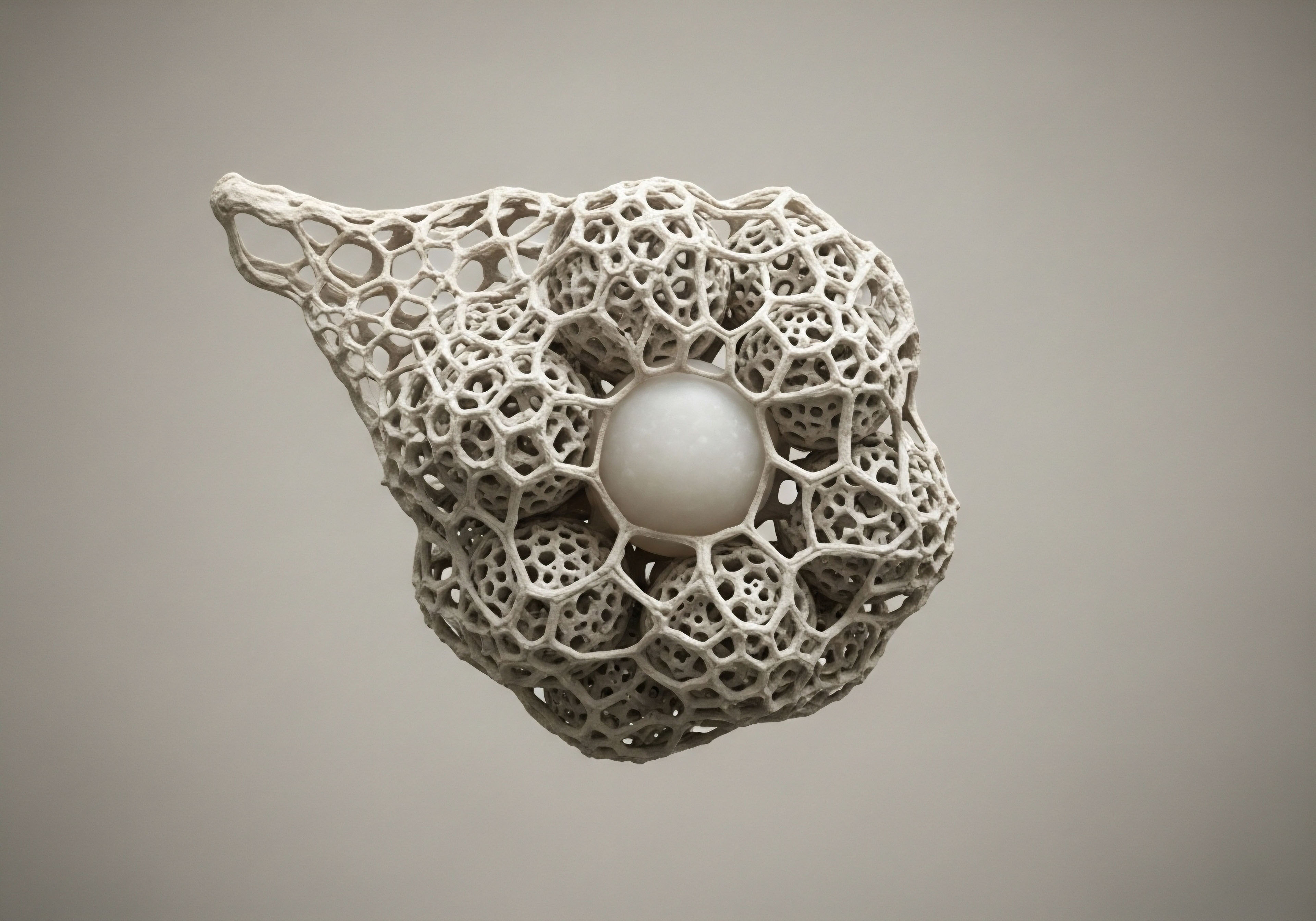

The Endocrine Signal
The prevailing model of fitness is fundamentally incomplete. It is built upon the mechanics of movement ∞ calories expended, miles logged, weight lifted. This is the equivalent of measuring a vehicle’s performance solely by its mileage, while ignoring the sophisticated computer that governs its engine, fuel injection, and transmission.
The body’s true operating system is the endocrine network, a dynamic communication grid that uses hormones as its primary data packets. These molecules are the master regulators of performance, dictating everything from metabolic rate and muscle protein synthesis to cognitive drive and recovery. Focusing on the treadmill addresses the chassis while neglecting the code. Biology beyond this mechanical view means interfacing directly with the body’s signaling language to rewrite the parameters of performance and vitality.

Hormones the Information Molecules
Hormones such as testosterone, growth hormone (GH), and insulin are the executives of your biology. They issue commands that determine whether energy is stored as fat or used to build muscle, how quickly cells repair after damage, and how the brain perceives effort and motivation.
Resistance training, for example, is potent because it sends a powerful acute signal that stimulates the release of anabolic hormones like testosterone and GH. Protocols high in volume, moderate to high in intensity, and using short rest intervals produce the greatest hormonal elevations, creating an internal environment primed for growth and adaptation. The mechanical stress is merely the trigger; the resulting hormonal cascade is the mechanism of transformation.

The Axis of Control
The Hypothalamic-Pituitary-Gonadal (HPG) axis is the central command for much of this signaling. It is a sensitive feedback loop that regulates the production of key performance hormones. Factors like poor sleep, chronic stress, and nutrient deficiencies can dysregulate this system, effectively throttling your biological potential.
Understanding this axis means recognizing that symptoms like fatigue, stalled progress, or mental fog are data points indicating a system in need of recalibration. The goal is to move from passively accepting these outputs to actively managing the inputs to optimize the entire system’s function. This requires a shift in perspective from exercise as a depleting activity to training as a targeted stimulus for a desired endocrine response.


The Molecular Toolkit
Optimizing the body’s hormonal and metabolic signals requires a set of precise, powerful tools. This toolkit moves beyond generalized prescriptions of “eat less, move more” into the realm of specific molecular interventions. The objective is to provide the body with the exact stimuli and raw materials needed to construct a higher level of function.
This involves leveraging resistance training as a signaling event, structuring nutrition to support endocrine pathways, and, when necessary, employing advanced protocols to directly modulate the system.

Targeted Stimulus through Resistance
Resistance training is the single most effective endogenous tool for hormonal optimization. Its value lies in its ability to generate a potent anabolic signal. The protocol itself is the key to the outcome.
- Compound Movements ∞ Exercises like squats, deadlifts, and presses recruit the largest amount of muscle mass, triggering the most significant release of testosterone and growth hormone.
- Intensity and Volume ∞ Training with heavy loads (85-95% of 1-repetition maximum) and sufficient volume acts as the primary driver for acute anabolic hormone secretion.
- Rest Intervals ∞ Short rest periods, typically 30 to 60 seconds, are shown to maximize the acute hormonal response, particularly for GH.
This approach treats the gym as a laboratory for generating specific biological signals, a far more sophisticated application than simply burning calories.
Regular exercise is a formidable regulator of insulin sensitivity and overall systemic metabolism through both acute events driven by each exercise bout and through chronic adaptations.

Nutritional Architecture
Nutrition provides the chemical building blocks for the hormones themselves and modulates critical metabolic pathways. An optimized nutritional strategy is designed to support the endocrine system directly.
| Component | Mechanism of Action | Practical Application |
|---|---|---|
| Protein Intake | Provides amino acids essential for muscle protein synthesis and repair, a process governed by hormones like testosterone and IGF-1. | Consistent intake of high-quality protein distributed throughout the day to maintain a positive nitrogen balance. |
| Micronutrients | Zinc, Magnesium, and Vitamin D are critical cofactors in the testosterone synthesis pathway. Deficiencies can directly impair hormone production. | Targeted supplementation based on blood panel analysis to correct deficiencies and support optimal endocrine function. |
| Carbohydrate Timing | Strategic carbohydrate intake can help manage cortisol, the primary catabolic hormone, especially post-workout. It also supports insulin sensitivity. | Consumption of carbohydrates around training sessions to replenish glycogen and blunt excessive cortisol production. |


The Chronology of Control
Intervention is a matter of precision and timing. The decision to modulate your biology is initiated when subjective experience aligns with objective data, indicating a divergence from optimal function. This is a proactive stance, moving from a reactive model of treating disease to a forward-looking model of engineering vitality.
The timeline for results is dictated by the specific intervention and the responsiveness of the individual’s unique biological system. It is a process of deliberate, measured inputs designed to produce predictable, quantifiable outputs.

Identifying the Intervention Threshold
The entry point for optimization is the identification of a clear signal. This signal is twofold ∞ the subjective sense of diminished capacity ∞ persistent fatigue, cognitive friction, or physical plateaus ∞ and the objective, verifiable data from comprehensive biomarker analysis.
- Comprehensive Blood Panels ∞ The initial step is to move beyond guessing. A full panel should assess not just total testosterone, but free and bioavailable levels, SHBG, estrogen, thyroid function, and markers of insulin sensitivity. This provides a detailed map of the current endocrine and metabolic reality.
- Symptom Correlation ∞ The data is then correlated with lived experience. Low free testosterone combined with reported low energy and drive provides a clear rationale for intervention. High cortisol paired with poor recovery and sleep signals a need for stress modulation strategies.
- Foundational Optimization ∞ Before advanced interventions are considered, the foundational elements must be dialed in. This includes optimizing sleep, nutrition, and training protocols. Many hormonal imbalances can be corrected at this stage.

Expected Timelines and Adaptation
Once a course of action is implemented, the biological response follows a predictable, albeit individualized, timeline. Foundational lifestyle changes, such as disciplined sleep and targeted nutrition, can improve markers like insulin sensitivity and cortisol levels within weeks. Hormonal optimization therapies, when clinically indicated, produce more rapid and pronounced effects.
Increases in testosterone can lead to noticeable improvements in energy, mood, and libido within the first month, with changes in body composition and strength manifesting over three to six months. The process is iterative ∞ monitor, assess, adjust. Regular testing ensures the system is moving toward the desired state, allowing for the precise calibration of inputs to secure the optimal biological state.

The Post Human Condition
We stand at a unique inflection point in human history. For millennia, our biology was a fixed variable, an unchangeable inheritance to be endured. The tools of the modern era ∞ endocrinology, molecular biology, data analysis ∞ have inverted this relationship. We now possess the capacity to read, interpret, and write our own biological code.
The transition from a passive acceptance of age-related decline to the active management of our own vitality is the most significant upgrade available. This is biology beyond the treadmill. It is the deliberate and precise engineering of the human machine for its highest expression of strength, cognition, and resilience. This is the new frontier, a domain where the limits are no longer defined by our genes, but by our courage and intellect to redesign them.



